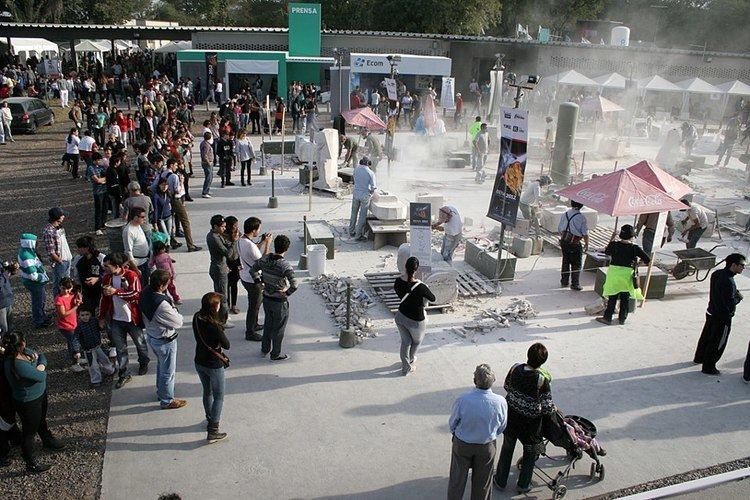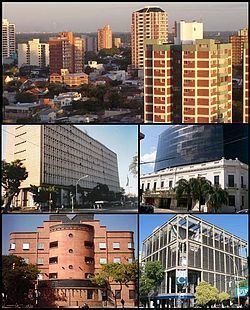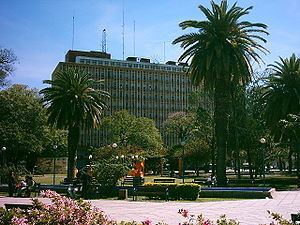Country Area 562 km2 | Population 229,212 (1991) Mayor Aida Ayala | |
 | ||
University National Technological University, Resistencia Regional Faculty | ||
Map of Resistencia, Chaco
Resistencia ([resisˈtensja]) is the capital and largest city of the province of Chaco in north-eastern Argentina. According to the 2010 census, the population of the city proper was 291,720 inhabitants. It is the anchor of a larger metropolitan area, Greater Resistencia, which comprises three more municipalities for a total population of 387,340 as of 2010. This conurbation is the largest in the province, and the eleventh most populous in the country. It is located along the Negro River, a tributary of the much larger Paraná River, opposite the city of Corrientes, Corrientes Province.
Contents
- Map of Resistencia Chaco
- English project 2011 a city tour resistencia chaco argentina
- Resistencia chaco argentina city tour
- Climate
- Economy
- Culture
- Transport
- Sister cities
- Notable people
- References

The area was originally inhabited by Guaycuru aboriginals such as the Tobas. Their resistance to evangelisation postponed substantial European settlement until the late 19th century. Not until 1865 was a proper settlement established, and on January 27, 1878, Resistencia was formally established as the territorial capital. The national government supported immigration, and in 1878 the first Italian immigrants arrived. The first City Council was made up entirely of members originating from that country.

English project 2011 a city tour resistencia chaco argentina
Resistencia chaco argentina city tour
Climate

Resistencia is one of the warmest cities in Argentina, and is known for its extremely hot, humid summer weather with frequent lightning. The climate is humid subtropical (Köppen climate classification Cfa), with a cooler, dryer season and a long, humid summer. Fall and spring are often marked by sudden transitions from summer weather patterns to winter weather patterns.
During the summer, temperatures attain highs of 30 to 35 °C (86.0 to 95.0 °F) on a daily basis, and occasionally up to 38 °C (100.4 °F). The record temperature is 43.5 °C (110.3 °F) on November 2, 2009. Nights are warm and sticky, between 19 to 25 °C (66.2 to 77.0 °F), and afternoon thunderstorms are common. The transition to fall is slow: March's temperatures are very similar to midsummer, and April is still warm with an average high of 26.2 °C (79.2 °F) and a low of 17.0 °C (62.6 °F), and rainfall is very abundant: 284.9 millimetres (11 in) during that month. The dry, cool season starts in May and lasts until September. During its peak in June and July, the average high is 20 °C (68.0 °F) and the average low is 10 °C (50.0 °F), with rainfall below 50 millimetres (2 in) in a month. These averages reflect the fact that there are two distinct weather patterns that alternate in the winter: the northerly, tropical pattern, and the southerly pattern of the Pampas: thus, there are periods of very warm, dry weather (25 to 30 °C (77.0 to 86.0 °F)) with warm nights (15 °C (59.0 °F)) followed by strong southerly winds, often accompanied with drizzle and temperatures that hover around 10 °C (50.0 °F) for days at a time (creating a surprisingly cold feeling), followed by dry air and blue skies and cold nights (2 to 6 °C (35.6 to 42.8 °F)) and pleasant, cool days between 15 and 20 °C (59.0 and 68.0 °F)). Light frost occurs under very calm conditions with cold air in place; usually measured temperatures will hover between 0 and 3 °C (32.0 and 37.4 °F) but frost will cover the ground. On occasion, however, under very cold weather patterns, measured temperatures reach −2 °C (28.4 °F), with a record low of −4.7 °C (23.5 °F) on June 29, 1996.
Economy
The city's economy, originally based on agriculture and trade, has diversified into the service sector in recent decades.
Culture
Resistencia is known nationally as the "city of sculptures" and "open-air museum" because of the more than 500 monuments and other works of art spread among its streets.
The city has organized a Biennial International Sculptures Contest since 1988; after each contest the sculptures remain in the city for public display in parks or sidewalks. Since 1997, the event has been sponsored by UNESCO. Resistencia is also home to a number of museums, including the René Bruseau Provincial Museum of Fine Arts, the Augusto Schulz Museum of Natural History, the Juan Alfredo Martinet Museum of Anthropology, the Ichoalay Cultural Museum, and the Ertivio Acosta Museum of Man in Chaco.
Transport
The city has been served by Resistencia International Airport since 1965; its terminal, completed in 1971, was designed by renowned modernist architect Amancio Williams. Its access via highways includes National Route 11 (north to south), National Route 16 (westbound), and the General Belgrano Bridge, which has connected Resistencia to its twin port city of Corrientes since 1973. Following the closure of rail lines in the area during the privatization of the nation's railways in the early 1990s, the city's rail links were re-established with the opening of the provincially funded Sefecha line in 1997.
Sister cities
Resistencia has five sister cities:
